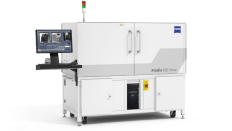Failure Analysis
It is desirable to preserve a valuable FA sample as intact as possible so that the maximum information about the failure mechanism can be revealed. While the sophistication of techniques for fault isolation is increasing, it is getting more difficult to characterize defect structure and diagnose failure mechanisms without resorting to destructive methods owing to increased complexity of packaging architectures. Other traditional non-destructive methods such as optical microscopy, infrared microscopy, and scanning acoustic microscopy, face increasing difficulties since most failed structures are buried deep in packages and feature sizes are small. ZEISS XRM offers a viable high-resolution non-destructive solution for fault isolation and failure analysis. Physically destructive methods can be carried out based on information collected during X-ray microscopic analysis.
Characterization & Analysis
- Virtually cross-section a package along any arbitrary plane to expose buried defects
- Acquire high-resolution images for fault regions and help reveal physical evidence for failure mechanisms
- Provide 3D geometric information for more precise physical cross-section
- Replace physical cross-sectioning process (case by case)
- Image defective structures causing electrical open or short
- Assess structural response of a package to thermal cycle test
- Segment different materials based on density variance, such as voids in bumps
- Maintain high resolution over large working distances, visualizing micron-sized defects in a 4”x8” circuit board
- Perform 3D visualization and structural characterization for C4 solder bumps, TSVs, copper pillars and BGAs, and defects
- Visualize defects in plating through via, metal trace, interconnects between bump and trace
- Gain contextual information that can improve the opportunity for success of higher resolution, destructive cross-sectioning techniques
- Segment and quantify voids on C4, performing bump-to-bump statistical void analysis such as bump size distribution and void fraction distribution
- Characterize structure and defects of microfabricated nozzles and ink channels for commercialized print head.
- Visualize Si die cracks (case by case)
- Image Si diaphragms in micro-acoustical devices such as microphone and high-fidelity speakers
The Link to Correlative Microscopy
The new FA workflow: identify the approximate region of interest (ROI) with a low-resolution non-destructive technique. Use ZEISS Xradia Versa to zoom in on ROI within a package to produce submicron resolution images for deep visualization and failure classification. Perform progressive testing and additional experiments, re-imaging non-destructively. For the final step, mechanical cross-sectioning via FIB-SEM saves a significant amount of time since XRM data provides detailed structural information prior to doing so.

